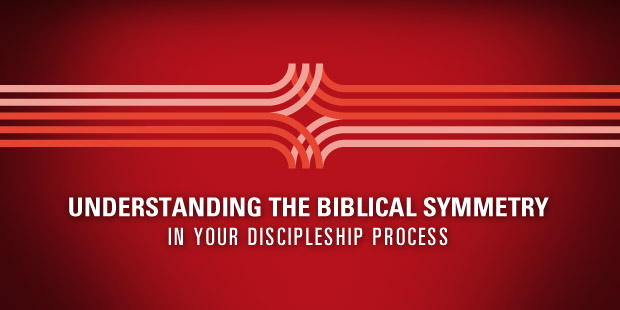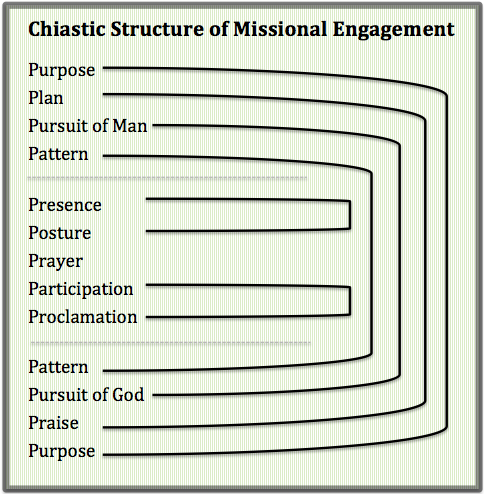
Understanding the Biblical Symmetry in Your Discipleship Process
I believe there is biblical symmetry in how we enter missionally and how we make disciples by joining them to invite us into this life on mission. That symmetry is best explained by looking at a language device known as a chiasm.
A chiasm is simply a learning device to draw connections and parallels in concentric fashion, usually working from the outside in. Examples would be ABC-CBA (the two A’s parallel, the two B’s parallel, and the two C’s parallel). This is also a way of drawing emphasis, usually the center being the most important pairs of parallels.
Reflecting with my disciple-making team, I believe there is a chiastic structure to missional discipleship. In order to make the parallels memorable, all of the parts of the structure begin with the letter “P” (and all Southern Baptists say a hearty “amen”). Here’s the chiastic structure:
MISSIONAL
Last week, I wrote about “owning my own square mile” based on coming to terms with God’s purposes and providence/plan for my life. I genuinely believe that a high view of God’s sovereignty does not marginalize mission but actually mobilizes mission. God’s purpose is that His people who represent Him on earth–His character, His Ways, and His gospel. God has a plan to bring about His eternal purposes culminating in the glorification of His Son from every nation, tongue, and tribe. That plan is through the local church to proclaim the gospel of God which brings about the obedience of faith to those becoming like Christ in all things. God is the great Evangelist who plans salvation (Father), purchases salvation (Son), and personalizes salvation (Holy Spirit).
As a disciple of Jesus, I’m called to follow Him on mission to love God and love others, to become a fisher of men, laborer in His harvest field, ambassador of His gospel, and soldier in His army. My life should be characterized by the pursuit of man–of sinners far from God–who become the object of my affection, the subject of my prayers, and the prospect of kingdom advance. In order for this pursuit of man to become meaningful, I must pattern my life after the priority of the kingdom of God and making the gospel of first importance. Because I have been sent into the world by Jesus (John 20:21), my life should reflect a pattern indicating a pursuit for sinners because of God’s purposeful and providential placement.
At the heart of the missional discipleship chiasm is incarnational mission. Jesus entered into our world by taking on flesh and living among us. There was a nearness to God in the incarnation that made his immanence accommodating to our neediness. The same is true for Jesus’ disciples. We pattern our lives as sent disciples of Jesus on mission to have a presence in the midst of the people we are called to reach. We enter into the world, not becoming worldly in the sinful sense but in the practical sense (what John Stott called “holy worldliness“), interweaving our lives in the fabric of the community. There’s a going aspect of mission as well as a dwelling aspect of mission. When a there is a patterned life of being present in the community, disciples of Jesus display a posture of humble, sacrificial living. We are not postured as better or privileged but as forgiven and filled with gratitude. Like Jesus, we want to serve, not be served, to go to them, not expect them to come to us, to have a towel and basin as our calling card, not our protagonist positions against all the sinful things sinners do. This is the “incarnational” component (presence and posture).
The mission component at the center has to do with participation (a visible presentation of the gospel) and proclamation (a verbal presentation of the gospel). As disciples of Jesus, we called to show (participate) and share (proclaim) the Gospel of the kingdom, calling sinners to repent and believe while living a lifestyle of repentance and faith. The earthly ministry of Jesus, as well as the early church, demonstrated a healthy balance of word and deed. Having a presence and posture isn’t enough, but it does position a disciple to have perpetual opportunities for meaningful participation in, and sincere proclamation of, the gospel of Jesus Christ.
At the very center of the chiastic structure is prayer. That is because there prayer is the genesis of missional discipleship. Jesus saw the expansive need of the multitudes of people and called His disciples to pray to the Lord of the harvest. Before the calling of disciples in Matthew 10 was the call to pray in Matthew 9. Before Pentecost in Acts 2 was prayer in the upper room in Acts 1. Before there is any real demonstration of life on mission making disciples of Jesus, there will be a life deeply marked by prayer. This kind of life is simply impossible left to our own resources. I don’t care how gifted you are. Jesus said, “Apart from me you can do nothing” (John 15:5). Prayer turns us away from a life of unbelief, arguing about our incompetencies and justifying our disobedience to a life of faith, embracing God’s provision and promise of the Holy Spirit to empower us supernaturally.
DISCIPLESHIP
Here’s where the chiasm finds its parallel and symmetrical balance. Through the gospel, sinners are saved and called to a life of following Jesus. What does that look like? Where do these new believers begin? The nearest and clearest thing to them will be the person who shared and showed the gospel to them. The new disciple of Jesus learns what it is like to know and follow God by knowing and following the pattern of Christians investing in their life. This is the second layer of living a patterned life. As I mentioned above, the first layer is missional–we pattern our lives because we have been sent on mission for the global and glorious purposes of God. The second layer is discipleship–we pattern our lives because we serve as a template and guide of what it means to live “in Christ” and have all areas brought under His Lordship.
When new Christians follow the faithful pattern of gospel-driven disciples, they will grow in grace and knowledge of Jesus, cultivating a passion and pursuit of God. Their spiritual pacesetters are encouraging and challenging them to go hard after God and make it their life’s ambition to know and enjoy Him. At one level, disciples of Jesus are characterized by a passionate pursuit of man (missionally); at another level, disciples of Jesus are characterized by a passionate pursuit of God (discipleship). It is not either-or but both-and. You cannot have one without the other.
When disciples of Jesus are utterly satisfied with all that God is for them in Christ, their lives will demonstrate a “sacrifice of praise“. They will exhibit the truth that we are a royal priesthood and holy nation to “declare the praises of Him who called us out of darkness and into His marvellous light.” Indeed, everything in discipleship conforms to the plan to make us into the image of Jesus Christ, all owed to “the praise of His glorious grace.” Missional discipleship redounds to the praise and celebration of Jesus Christ–Redeemer, Savior, King.
We begin with God’s purpose to mobilize us on mission. We end with God’s purpose to unite all things in Christ. What God began, He will certainly complete. He does all things well. Our purpose is to make, mature, mobilize, and multiply disciples on mission because our missionary God will not cease working through His church until His eternal purposes are complete. If you don’t have a high view of God’s purpose, you will not be mobilized on mission. You will also not be a devoted disciple-maker. Missional discipleship has at its bookends God’s glory, and at its heart the prayerful cry, “Hallowed be your name. Your kingdom come, your will be done, on earth as it is in heaven!”
So there you go. That’s the chiastic structure of missional discipleship. It’s one thing to lay hold of it conceptually; it’s another thing to lay hold of it experientially. Which reminds me, I need to take some time to pray.
Read more from Timmy here.

Tags: Discipleship, Multiplication, Timmy Brister












